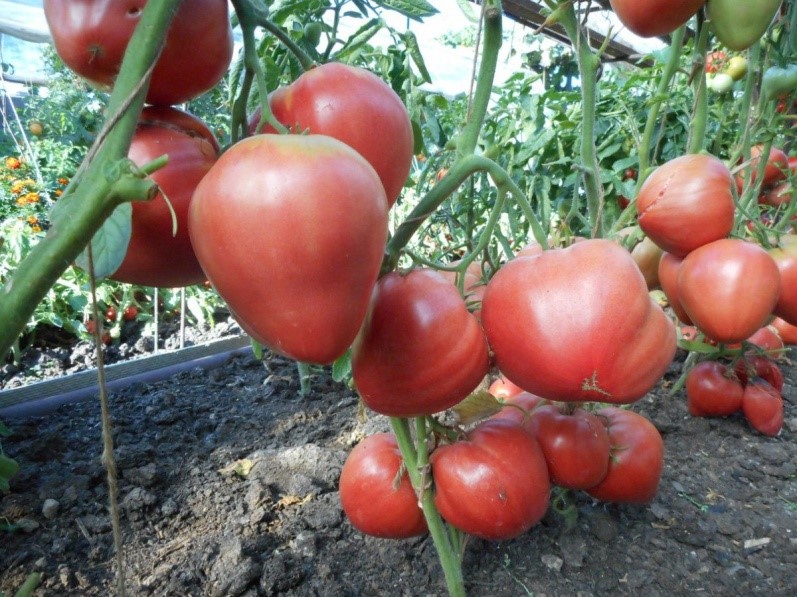 Tomato Eagle's beak was bred by Russian breeders specifically for the Siberian climate and it is there that it is mainly grown. This is a very popular, unusual and amazing variety of tomato.
Tomato Eagle's beak was bred by Russian breeders specifically for the Siberian climate and it is there that it is mainly grown. This is a very popular, unusual and amazing variety of tomato.
With its excellent taste, unusual shape and high yield, it will appeal to even picky gourmets. If you look at photographs of the fruits of the tomato Eagle's Beak, there is no doubt about the correct choice of its name - their shape clearly reminds tomatoes bird's head.
Content
Description of tomato variety Eagle beak
The eagle's beak is a large-fruited type of tomato that combines the advantages of both indent and determinant. It is more likely to have a medium maturity than early ripening. You can see the first fruits of the Eagle's beak 110-115 days after the formation of the first shoots. Tomato perfectly exists and grows anywhere - on the open ground, in a greenhouse and greenhouse.
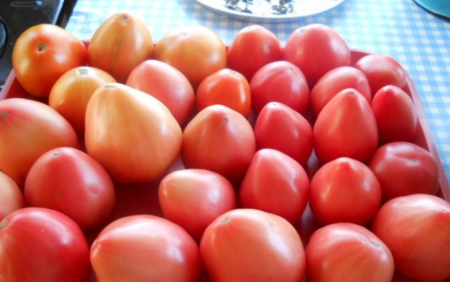
In addition, the tomato is highly resistant to diseases such as fusarium, late blight, tobacco mosaic. However, in order to better be safe and secure the seedlings, taking preventive measures: calcine the ground for seedlings (thereby neutralizing it), spray the vegetable with phytosporin or any other biological preparations, preparations containing copper, use a solution of potassium permanganate, etc.
The benefits of tomato Eagle beak and its characteristics
A lot of advantages and positive qualities that this amazing tomato possesses can be seen already in its main characteristic:
- grows to one and a half meters (in a greenhouse, under good conditions, it can reach 2 meters in height), so the bushes require additional support, like their fruiting branches;
- large fruits - on average about 600-800 grams (closer to the end of fruiting - 200-400 grams);
- it is steady against cold weather - fruits ripen safely in the fall, frosts are not terrible for them;
- good productivity - from one square meter you can collect 10-14 kilograms of tomatoes;
- the seeds can be collected by yourself and used for sowing the next year, since this tomato variety is not hybrid;
- universal tomato, which can be used in any dishes (from salads to preservation) and in any form, both raw and cooked;
- a peculiar appearance of tomatoes, which is also used for decorating various dishes;
- the fruit pulp is very juicy and perfect for making tomato juices;
- color - red with an orange tint or raspberry pink;
- the fruits smell pleasant, taste sweet and juicy, almost without acidity, with a small amount of seeds;
- the skin is dense, which prevents the tomatoes from cracking.
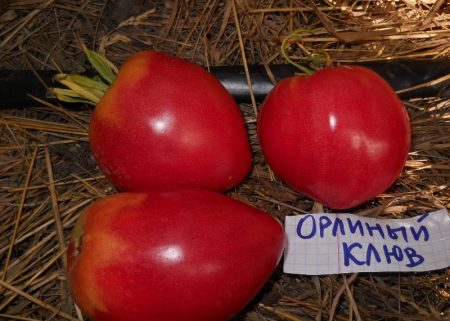
Variety disadvantages
And if we talk about the shortcomings (and this is too critical a definition), then it is worth noting that for most gardeners they are not minuses, but only normal requirements for the successful cultivation of tomatoes. It is worthwhile to foresee and identify the vulnerabilities of the Eagle's Beak tomato in order to prevent mistakes in its cultivation.
The disadvantages of tomato:
- requires plentiful top dressing and constant watering, like all large varieties of tomatoes;
- it is necessary to engage in the formation of a vegetable, to regularly plant it, as stepsons grow very quickly;
- the fruiting bush needs to be tied up branches and the construction of a support, since its fruits are heavy and can simply break the plant, and these measures take a lot of time.
However, despite all the apparent inconvenience and disadvantages of the variety, it should be noted that each type of tomato has its own characteristics and each needs its own individual approach. It is worth trying a little in the cultivation of the tomato Eagle's beak and then for a long time to enjoy its plentiful and tasty harvest.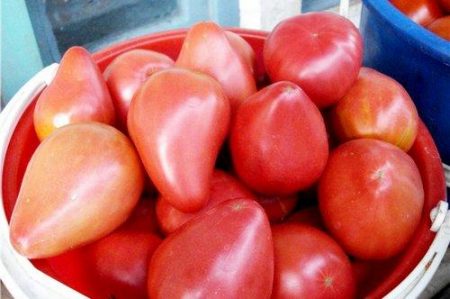
Features and nuances of growing
Before planting tomato seeds, the Eagle Beak is recommended to be tested for germination by soaking them. Planting material should be sent to clean water and left to swell for several hours. Seeds cannot be kept in water for longer than 20 hours. Otherwise, they will suffocate and will not be able to germinate.
The best time to send planting material to seedlings is from early March to early April. Soil is prepared in advance or bought in stores. The best option for the soil is a mixture of land from the site, sand and peat. If desired or necessary, gardeners supplement the soil with humus and a small amount of wood ash, which reduces the acidity of the soil.
Sowing of planting material is carried out 60-65 days before planting seedlings in the ground. You need to dive the plant after the appearance of 2 full leaves. When planting in the ground, it is worth placing the plants away from each other. Optimal - up to 3 bushes per 1 square meter.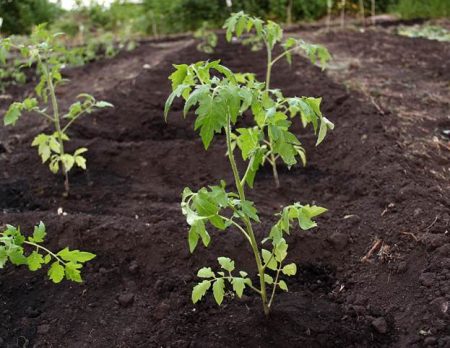
All that is needed next is regular watering, top dressing, pinching, weeding the ground for air access and getting rid of weeds, and preventing diseases and pests.
If you follow all the requirements, then there is no doubt that the handsome tomato Eagle Beak will grow in the garden, and vegetable growers can count on a large crop of tomatoes.
Reviews about tomato Eagle Beak
Svetlana Olegovna, 33 years old, Barnaul
I acquired a new tomato variety 3 years ago. I then trusted the opinion of the neighbors who advised and praised the Eagle's beak. They even sampled some tomatoes, they tasted delicious and smelled really good. My homemade lettuce in a matter of minutes. And in growing tomato is very unpretentious and productive. I will plant all the time.
Mikhail Valerevich, 39 years old, Kemerovo
I bought and planted a tomato last year and plan to do it again now. The eagle's beak is very unpretentious, you just need to properly care for it, as well as for all other tomatoes and productivity will only please you. This is the kind of my dream. Normal care - excellent result!
Lyudmila Nikolaevna, 40 years old, Irkutsk
Eagle beak acquired, trusting reviews on the Internet. And I was not mistaken! Everything that I read about the tomato, then I see on my site. I especially love it in salads, and make juice for the winter. It is just a fabulously delicious tomato.




 Low-growing tomatoes, without pinching: 5 of the most delicious varieties
Low-growing tomatoes, without pinching: 5 of the most delicious varieties Why tomato seedlings grow poorly
Why tomato seedlings grow poorly We grow a tomato in a shell
We grow a tomato in a shell Growing tomatoes without watering according to the method of Kazarin
Growing tomatoes without watering according to the method of Kazarin